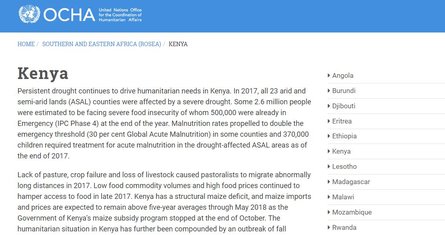
Persistent drought continues to drive humanitarian needs in Kenya. In 2017, all 23 arid and semi-arid lands (ASAL) counties were affected by a severe drought. Some 2.6 million people were estimated to be facing severe food insecurity of whom 500,000 were already in Emergency (IPC Phase 4) at the end of the year. Malnutrition rates propelled to double the emergency threshold (30 per cent Global Acute Malnutrition) in some counties and 370,000 children required treatment for acute malnutrition in the drought-affected ASAL areas as of the end of 2017.
Lack of pasture, crop failure and loss of livestock caused pastoralists to migrate abnormally long distances in 2017. Low food commodity volumes and high food prices continued to hamper access to food in late 2017. Kenya has a structural maize deficit, and maize imports and prices are expected to remain above five-year averages through May 2018 as the Government of Kenya’s maize subsidy program stopped at the end of October. The humanitarian situation in Kenya has further been compounded by an outbreak of fall armyworm, affecting 40 out of 47 counties in Kenya. This has resulted in crop yield losses, particularly maize and wheat, in major producing counties.